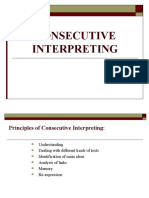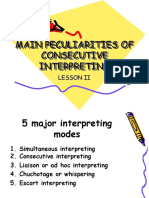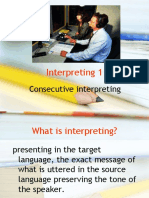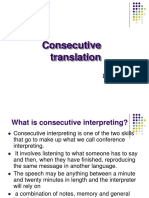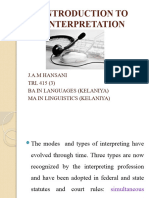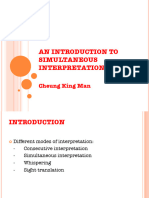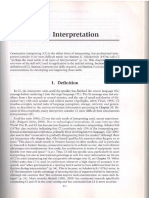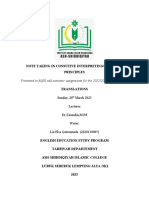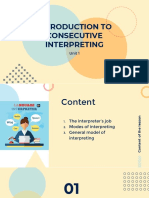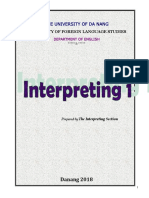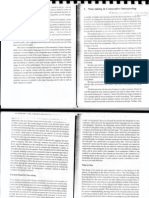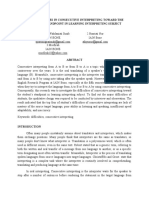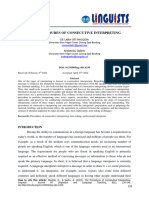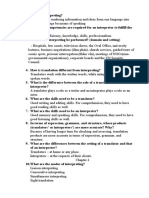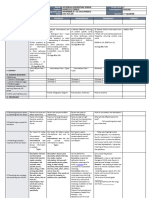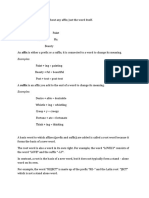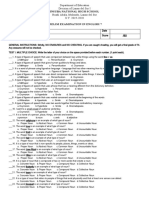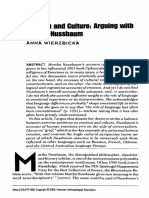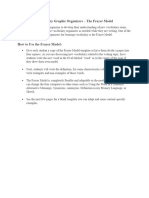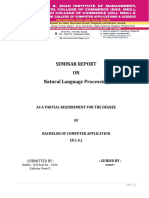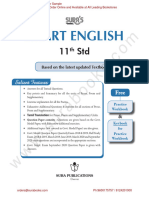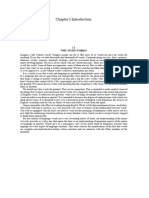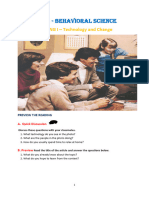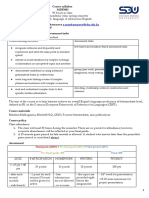UNIT 2: CONSECUTIVE INTERPRETING
Dam Thi Hong Nhung, MA.
v1.0024104208 1
� WARMING UP
Watch the sample video of consecutive interpretation and answer the following questions:
Link video
1. Which situation is consecutive interpreting being used in this clip?
2. What do you notice about the utterance of the speaker (the defendant’s speech)?
3. Does the interpreter need any specialized equipment?
2
v1.0024104208
� OBJECTIVES
• Present the definition, basic modes and Gile’s model of consecutive interpreting.
• Present three stages of a consecutive interpreter’s work
• Present skills needed for consecutive interpreting.
• Practice consecutive interpreting
3
v1.0024104208
� OVERVIEW
2.1 Introduction to consecutive interpreting
2.2 Three stages of a consecutive interpreter’s work
2.3 Skills needed in consecutive interpreting
2.4 Consecutive interpretation practice
4
v1.0024104208
� 2.1. INTRODUCTION TO CONSECUTIVE INTERPRETING
2.1.2. Two types of
2.1.1. Definitions
consecutive interpreting
2.1.3. Gile’s model of
consecutive interpreting
5
v1.0024104208
� 2.1.1. DEFINITIONS
• A process in which a speaker saying a sentence or two, then a pause is usually needed while the interpreter
render what was said into another language.
• A two-phase process of listening and reformulating.
• The interpreter sits or stands beside the source-language speaker.
• Requiring the interpreter to speak consecutively to the original speaker.
6
v1.0024104208
� 2.1.2. TWO TYPES OF CONSECUTIVE INTERPRETING
LONG CONSECUTIVE SHORT CONSECUTIVE
• Consecutively interpreting a lengthy • Consecutively interpreting a short
passage (over several minutes) or passage (a word to a few sentences).
possibly an entire speech at a time. • With or without the aid of notes.
• Usually with the aid of notes. • Reliant on memory.
• Better suited for official or diplomatic • More interactive and requires faster
occasions, when the speaker must have turn-taking between the speaker and the
an opportunity to deliver an entire interpreter in press conferences,
speech and cannot be interrupted. business meetings, etc.
7
v1.0024104208
� 2.1.3. GILE’S MODEL OF CONSECUTIVE INTERPRETING
THE PHASE OF LISTENING THE PHASE OF REFORMULATING
• Including listening to and comprehending the • Reading the notes
source language speech, then storing in • Retrieving information from short memories
memory and taking notes
• Reproducing the message in the target
• Using the note-taking technique to reduce language
memory load constraints
• A necessity for a good short-term memory
• Cooperation of these tasks
8
v1.0024104208
� 2.2. THREE STAGES OF A CONSECUTIVE INTERPRETER’S WORK
2.2.1. Understanding of the 2.2.2. The immediate analysis of
speaker’s original message content
2.2.3. The re-expression of the
same content in another language
9
v1.0024104208
� 2.2.1. UNDERSTANDING OF THE SPEAKER’S ORIGINAL MESSAGE
• Referring to not of words but of ideas
• Aiming at conveying concepts
• Dealing with the ignorance of unknown lexical items (words, idiomatic expressions, etc.)
• Asking for many years to form a professional, sufficient knowledge
10
v1.0024104208
� 2.2.2. THE IMMEDIATE ANALYSIS OF CONTENT
• Interpreters need to identify main ideas and give them their proper relevance in the interpretation.
• Ideas may be linked by logical consequences, logical causes, opposing concepts or put together without
cause ـeffect relation.
• If he/ she misses out significant points of the discourse, the result will be a seriously flawed performance.
• Interpreters should be capable of providing an exhaustive and precise summary of what has been said.
• The interpreter has to stress the most important ideas of a speech and leave out anything which is irrelevant
to the understanding of the original message.
11
v1.0024104208
� 2.2.3. THE RE-EXPRESSION OF THE SAME CONTENT IN ANOTHER LANGUAGE
• The role of interpreters is not to give an academically perfect translation but to make sure the speaker is
understood by the audience.
• Interpreters have to establish contact with the audience as a public speaker, speaking clearly and precisely.
• Interpreters are supposed to make eye-contact with the audience and avoid looking at their notes all the time.
• The gist of the speech will be conveyed also by means of a correct use of pauses and changes in tone, in
order to enliven the performance.
12
v1.0024104208
� 2.2.3. THE RE-EXPRESSION OF THE SAME CONTENT IN ANOTHER LANGUAGE (cont.)
• Interpreters have to keep their working languages rich, lively, effective and up-to-date by following suggestions:
Being informed about the latest national/ international events.
Regular reading of a broad range of well-written publication in all working languages.
Watching television, see movies, listen to songs in their original language.
Taking advantage of all the possible resources available in their working languages.
13
v1.0024104208
� 2.3. SKILLS NEEDED IN CONSECUTIVE INTERPRETING
2.3.1. Memory 2.3.2. Note-taking
14
v1.0024104208
� 2.3.1. MEMORY
• A necessity for interpreters to have a good memory to recall information in great detail.
• Three types of memory:
Sensory Memory: a limited ability to store information for seconds.
Short Term Memory: much of our information saved here and information retained for between 15 and 30 seconds.
Long Term Memory: the lasting retention of information, from minutes to a lifetime.
15
v1.0024104208
� 2.3.1. MEMORY (cont.)
• Some common mnemonic techniques:
Internally visualizing the content of a speech, creating images in one's mind, and concentrating on ideas,
not on single words.
Connecting the main ideas to a series of numbers.
Concentrating on the main ideas and on the links among them, trying to reproduce the structure of the
speech as a kind of skeleton.
16
v1.0024104208
� 2.3.2. NOTE-TAKING
• Being very useful for the interpreter working consecutively for some reasons:
Helping interpreters improve concentration, prevent distraction and facilitate the reception and analysis of
the speech.
Helping interpreters relieve the memory.
Being able to activate the memory of the interpreter with cues or signals that call up the information in the speech.
Enabling the interpreter to visualize information including main ideas, secondary elements and the links
among them.
• Not being expected to be complete or organized exactly the same way as in the original speech.
• Aiming at providing the cues necessary to remember the information in the speech.
17
v1.0024104208
� 2.3.2. NOTE-TAKING (cont.)
• Important for interpreters to know what to note:
Main ideas: The interpreter is required to have the ability to identify, select and retain important ideas.
The Links: The connections between individual ideas determine the overall meaning of the speech.
- the logical consequence (consequently, as a result, accordingly or therefore).
- the logical cause (because, due to, as, or since).
- The opposition (but, yet, however or nevertheless).
Non-contextualised Information: the group of the elements that cannot be recalled on the basis of
analytical and logical thinking in a given context (Numbers, proper names, terminology).
Verb Tenses: They have decisive influence to the meaning of a sentence.
18
v1.0024104208
� 2.3.2. NOTE-TAKING (cont.)
• How to note:
Abbreviation
- An efficient tool to save the interpreter's effort on writing.
- Need to be developed beforehand.
- Must be unequivocal and unambiguous enough for the interpreter to understand immediately.
- Must be consistent.
- However, it tends to entice the interpreter to stick to the word level instead of meaning level.
1. kilometre Km 1. labour Lbr
2. kilowatt Kw 2. people Pp
3. kilowatt hour kwh 3. society Soc.
4. centimetre Cm 4. economy Eco.
5. millimetre mm 5. monetary Mon
19
v1.0024104208
� 2.3.2. NOTE-TAKING (cont.)
Symbols
- more preferable for their capacity of representing ideas and
eliminating source language interference.
- a mark, sign or letter used to represent a thing or a concept.
- quicker and easier to write than words.
- need to be prepared in advance.
- Must be consistent
20
v1.0024104208
� 2.3.2. NOTE-TAKING (cont.)
When to note:
- Starting the notes as soon as possible without having to wait for a complete unit of meaning.
- Taking notes right after sensing the meaning of a sentence.
- No need for the interpreter to wait until the speaker finishes an utterance.
- Stopping taking notes instantly as soon as speakers finish their utterances.
21
v1.0024104208
� 2.4. CONSECUTIVE INTERPRETING PRACTICE
Practice 1 (MT2.1): Read the following statements and decide whether they are true (T) or false (F)
1. Consecutive interpreting is a process in which a speaker saying only one sentence, then a pause is usually
needed while the interpreter render what was said into another language.
2. The interpreter sits or stands opposite the source-language speaker and does not need to make eye-
contact with the audience.
3. Consecutive interpretation is only suited for official or diplomatic occasions.
4. There are three stages of a consecutive interpreter’s work.
5. It is unnecessary for the interpreter to take note non-contextualised Information such as numbers, proper
names and terminology.
22
v1.0024104208
� 2.4. CONSECUTIVE INTERPRETING PRACTICE (cont.)
Practice 1 (MT2.1): Read the following statements and decide whether they are true (T) or false (F)
Answers:
1. Consecutive interpreting is a process in which a speaker saying only one sentence, then a pause is usually
needed while the interpreter render what was said into another language. False (F)
2. The interpreter sits or stands opposite the source-language speaker and does not need to make eye-
contact with the audience. False (F)
3. Consecutive interpretation is only suited for official or diplomatic occasions. False (F)
4. There are three stages of a consecutive interpreter’s work. True (T)
5. It is unnecessary for the interpreter to take note non-contextualised Information such as numbers, proper
names and terminology. False (F)
23
v1.0024104208
� 2.4. CONSECUTIVE INTERPRETING PRACTICE (cont.)
Practice 2 (MT2.2): Categorize the following roles of the interpreter in two phases of consecutive
interpreting into the correct group
• listening to source language speech • producing notes
• comprehension of source language utterances • information stored in the memory
• retrieving information from the memory • cooperating between listening, analysing and note-taking
• reproducing messages in target language • reading notes
The listening phase The reformulating phase
24
v1.0024104208
� 2.4. CONSECUTIVE INTERPRETING PRACTICE (cont.)
Practice 2 (MT2.2): Categorize the following characteristics of sight translation into the correct group.
Answers:
The listening phase The reformulating phase
• listening to source language speech • reading notes
• comprehension of source language utterances • retrieving information from the memory
• information stored in the memory • reproducing messages in target language
• producing notes
• cooperating between listening, analysing and note-taking
25
v1.0024104208
� 2.4. CONSECUTIVE INTERPRETING PRACTICE (cont.)
Practice 3 (MT2.3): Fill in the blanks with no more than three words to complete the text below about
stages of a consecutive interpreter’s work
Three stages of a consecutive interpreter's work are the understanding of the speaker's (1) ____________, the
immediate analysis of its content and the re-expression of the same content in another language, with the help
of some notes the interpreter writes down upon hearing the original message The understanding we refer to
here is not of words but of ideas, since an interpreter has to convey concepts. In the analysis of a message,
the interpreter has to (2) ____________ and give them proper relevance in the interpretation. Ideas may be
linked by (3) ____________, logical causes, put together without cause - effect relation, and may also be
expressed by a series of opposing concepts. After understanding and analyzing, interpreters have to re-
express the speech they have just heard. Interpreters must recognize that they are (4) ____________ and
therefore they have to (5) ____________ with the audience, speaking clearly and articulating precisely.
26
v1.0024104208
� 2.4. CONSECUTIVE INTERPRETING PRACTICE (cont.)
Practice 3 (MT2.3): Fill in the blanks with no more than three words to complete the text below about
stages of a consecutive interpreter’s work
Answers:
Three stages of a consecutive interpreter's work are the understanding of the speaker’s (1) original message,
the immediate analysis of its content and the re-expression of the same content in another language, with the
help of some notes the interpreter writes down upon hearing the original message. The understanding we refer
to here is not of words but of ideas, since an interpreter has to convey concepts. In the analysis of a message,
the interpreter has to (2) identify main ideas and give them proper relevance in the interpretation. Ideas may be
linked by (3) logical consequences, logical causes, put together without cause ـeffect relation, and may also be
expressed by a series of opposing concepts. After understanding and analyzing, interpreters have to re-
express the speech they have just heard. Interpreters must recognize that they are (4) public speakers and
therefore they have to (5) establish contact with the audience, speaking clearly and articulating precisely.
27
v1.0024104208
� 2.4. CONSECUTIVE INTERPRETING PRACTICE (cont.)
Practice 4 (MT2.4): Consecutive practice
• You will be given two short clips for practice, one is in English and the other is in Vietnamese.
• Follow the instructions in the next slide.
• Check what you have done to see what you have been able and unable to do using the checklist in the last
slide of Practice 4.
28
v1.0024104208
� 2.4. CONSECUTIVE INTERPRETING PRACTICE (cont.)
Practice 4 (MT2.4): Instructions for sight translation practice
Step 1: Preparation for consecutive interpreting
Take a look at the topic of the video. Do not play it yet. What you should do is to anticipate the vocabulary and
pinpoint potential ideas about that topic.
Play the video clip. Do not translate yet. Make segments by pausing after some sentences of the speaker. The
segments can be either two to three sentences - if they are short and simple or even one sentence - if the
sentence contains a number of specific details.
Prepare paper pages to take note.
29
v1.0024104208
� 2.4. CONSECUTIVE INTERPRETING PRACTICE (cont.)
Practice 4 (MT2.4): Instructions for sight translation practice
Step 2: Consecutive interpreting
• Start the voice recorder after you finish step 1.
• Play the video clip, take notes and make a pause following the segments designed in step 1.
• Right after the first segment stops, translate into the target language based on the note and on your short
memory. Remember to avoid looking at the note all the time.
• Right after the first segment is completed, repeat with the rest of the segment.
• Stop the voice recorder.
Step 3: Review
Listen to your recorded consecutive interpreting segment by segment and mark in the source-language words
or phrases or any ideas that you have failed to comprehend and deliver their meanings.
30
v1.0024104208
� 2.4. CONSECUTIVE INTERPRETING PRACTICE (cont.)
Practice 4 (MT2.4):
* Source videos for consecutive interpreting:
Link English video
* Source videos for consecutive interpreting:
Vietnamese video
31
v1.0024104208
� CHECKLIST: Tick (√) what you have done well
* In terms of transfer competency, I am able to…
Consecutively translate the content and intent of the message with few instances of minor omissions,
addition and/or distortions.
resolve meaning transfer problems appropriately.
fully control of my voice with clear pronunciation, fluent delivery, good tone and volume.
* In terms of language competency, I am able to…
use language competently and idiomatically.
make few minor errors in the use of pragmatics, lexicon, grammar, syntax, style and/or register without
impacts on meaning.
32
v1.0024104208
� SUMMARY
• Consecutive interpreting (CI) is a process in which a speaker saying a sentence or two, then a pause is
usually needed while the interpreter render what was said into another language.
• There are two types of CI including short CI and long CI.
• A CI process goes through 2 steps of listening and reformulating.
• Three stages of a consecutive interpreter’s work are understanding the speaker’s original message,
analysing the content immediately and re-expressing the same content in the target language.
• Memory and Note-taking are two important skills for a consecutive interpreter.
33
v1.0024104208
� GLOSSARY
• consecutive interpreting (n): loại hình dịch đuổi/ dịch nối tiếp
a process in which a speaker saying a sentence or two, then a pause is usually needed while the interpreter
render what was said into another language
• original (adj): nguồn, nguyên bản
spoken, written or existing first
• utterance (n): lời nói
something that someone says
• reformulate (v): tái tạo
say or write something in a different way
• visualise (v): hình dung
form a picture of someone or something in your mind
34
v1.0024104208
� GLOSSARY (cont.)
• non-contextualised (adj): không được đặt vào ngữ cảnh, không được ngữ cảnh hóa
not being considered in specific context
• abbreviation (n): chữ viết tắt
a short form of a word or phrase
• unequivocal (adj): rõ ràng, không mập mờ
expressed in a clear and certain way
35
v1.0024104208
� FAQ - Frequently asked questions
1. Trong dịch đuổi/ dịch nối tiếp, phiên dịch viên sẽ chuyển ngữ một chiều hay hai chiều?
Có thể một chiều hoặc hai chiều. Phiên dịch một chiều diễn ra khi người nói sử dụng một ngôn ngữ nguồn.
Phiên dịch hai chiều khi người nói sử dụng hai hay nhiều ngôn ngữ nguồn khác nhau.
2. Trong quá trình dịch, người dịch có thể tạm dừng người nói lại để hỏi thêm về nội dung không?
Câu trả lời là có. Trong quá trình dịch, người dịch có thể tạm dừng người nói để hỏi và thảo luận cho rõ về
nội dung người nói đã nói để dịch cho chính xác.
3. Người dịch có được chuẩn bị trước nội dung hay không?
Còn tùy thuộc vào yêu cầu của sự kiện/ diễn giả. Thông thường, trước mỗi sự kiện, phiên dịch viên sẽ được
thông tin cơ bản về diễn giả, chủ đề, kịch bản, thông tin về đối tác và sẽ được thông báo chi tiết nếu có từ
vựng, thuật ngữ chuyên ngành hay những thông tin quan trọng khác mà đối tác/ diễn giả yêu cầu.
36
v1.0024104208
� FAQ - Frequently asked questions (cont.)
4. Dịch đuổi/ Dịch nối tiếp thường được dùng trong trường hợp nào?
Dịch đuổi/ Dịch nối tiếp thường được dùng cho những buổi dịch không gian hẹp, có ít người tham dự như
phỏng vấn, họp báo, giao dịch, tòa án, vv.
5. Dịch nhìn văn bản cần có những kỹ năng gì?
Các kĩ năng cần thiết cho loại hình dịch đuổi có thể kể đến đó là: khả năng ghi nhớ dữ liệu trong thời gian
ngắn, khả năng ghi chú và sắp xếp dữ kiện nguồn và tổng hợp thông tin để chuyển ngữ; đặc biệt, người
dịch cần chuẩn bị tốt về vốn từ vựng, nhất là khi dịch thuật chuyên ngành.
6. Dịch đuổi/ Dịch nối tiếp có ưu/ nhược điểm gì?
Ưu điểm của phương pháp này là đảm bảo tính chính xác cao về nội dung cần truyền tải bởi người dịch có
thời gian để phân tích, cân nhắc lời dịch. Tuy nhiên, phương pháp này khá tốn thời gian.
37
v1.0024104208
